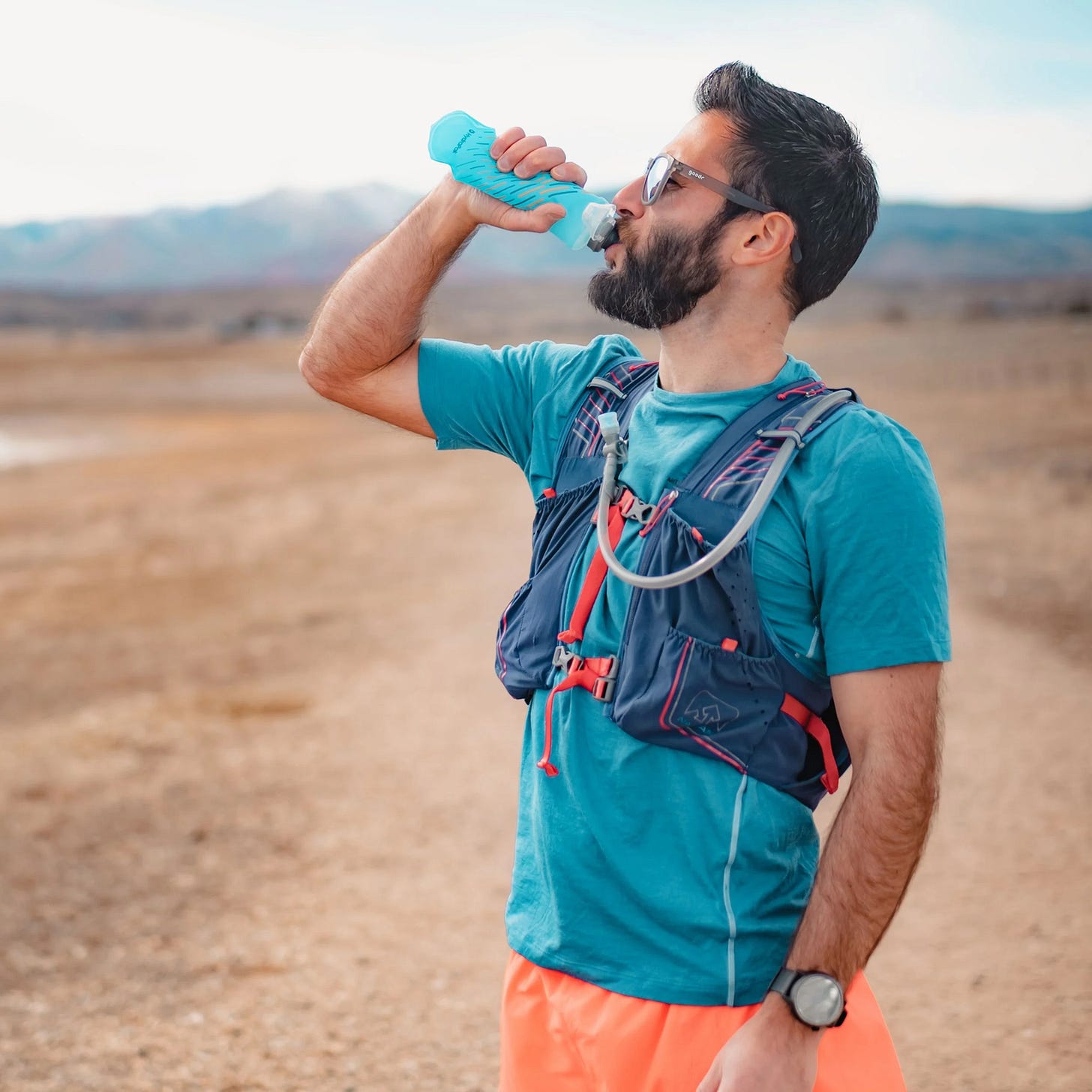My Top 5 Gear Essentials for Running
Spartan Beast Prep (Ep 3)
Hey everyone and welcome to another running article!
First of all, if you are new, welcome! Make sure you are subscribed and you can get these letters straight in your inbox!
Today’s article will be a little different. But hopefully it will still be helpful, interesting, and entertaining.
It turns out that running is a deceiving sport.
In more ways than one.
But today I want to talk about one misconception most people, including myself, have when they first get into running.
And that is…gear.
Let’s jump into it!
The Misconception
There is a major misconception in the sport of running. And that is that this sport is cheap.
All you need is a pair of shoes and the ability to run.
The beauty is that the ability to run is a free gift from God. I realize some people do not have that gift, but I also believe they do have other gifts. For God is a good God and the ability to run is just 1 of many different ways God can bless us.
But if you do have the ability to run, then it is true that it remains free. It doesn’t matter where you live, whether in the city, out in the country, another country altogether, or even on the moon.
You can find a place to go run. Sidewalks, trails, or even on the side of the road…just remember the safest way to run on the road is against traffic! I don’t know why more people don’t understand that.
So the misconception is a fair one. Finding a place to run is easy, even if you’re on vacation, there is never an excuse. It’s not like snowboarding where you need snowy mountains, most likely having to pay for a lift ticket, travel, etc just to enjoy your sport.
It’s also not like tennis, soccer, or basketball where you need specific courts, specific gear like rackets, ball, etc just to practice your sport.
For running, all you need is shoes. And even then some would argue you could go out and run barefoot just fine.
But that is where this misconception hides in waiting…gear.
Shoes are just the beginning. This sport is a slippery slope. Soon you need a fancy watch, headphones, a hat, sunglasses, different types of pants and shirts, and the list can go on and on.
All those different items add up pretty quickly.
Not to mention that the further you get into this sport, the more you run. The more you run, the faster you burn through those shoes. Nowadays a brand new pair of running shoes costs at least $120. And they can get up to almost $300 if you aren’t careful.
Speaking of shoes, if you ask any runner how many pairs of shoes they have, the answer will almost more than likely be greater than 1.
Some runners go crazy and have dozens of pairs of running shoes. But even the more modest runners still have 2-3 pairs at a time.
Gear isn’t even the end of it, either. I haven’t even mentioned the fact that those who get into this sport often like to race too. Race entry fees are not cheap, either!
So to summarize, running is a deceiving sport. Many people get into it because it’s the cheapest possible sport to pursue, but like all of life, there’s no such thing as a free lunch. So even running is an expensive sport…but does it have to be?
The Gear you Need
I mentioned in the last section a big long list of different gear, like sunglasses, fancy watches, etc.
But how much gear is actually necessary for pursuing running?
For instance, if you are a beginner, thinking of signing up for your first 5K, half marathon, or even full marathon, where do you begin?
Well, even though the mentality that running is “cheap” is not true. I do think it’s true to say that running is simple.
We, as humans, love to overcomplicate and overthink simple things. I don’t know why, but we do. And the reality is that all that extra gear like the watches and even the extra pairs of shoes are all just over-complications.
Are they all helpful in their own way? Sure! But are they helpful if they distract you from actually running? Not at all.
So if you are starting out, I suggest getting 1 pair of shoes that fit your feet. Get a real fitting from a real store and find a pair that work well with you. There are tons of confusing details like drop height, foam types, rollers, wide, narrow, etc.
Don’t get lost in those details at first.
But as you try a pair of shoes see what you think feels good when you run. Keep note if running in one pair of shoes causes you to feel pain in your knees, shins, etc.
Over time, as you try different shoes, you can eventually narrow down all those details and what works for your body mechanics.
But for now, just get 1 pair of shoes. Then start running in them regularly.
That’s it.
That’s all you need! You don’t even need headphones if you don’t have them. Run in silence and let your thoughts run wild. Or, if you do love music, run with your phone and play music out loud.
Nobody cares because everyone you pass will have headphones in.
You also don’t need a fancy watch. Your phone can track all of your runs, but to be honest, I don’t know if you even need to track your runs at first. I think it’s fun to track them and watch your progress over time, but if that overcomplicates things and keeps you from starting, then don’t do it!
So that really, truly, is all you need: 1 pair of shoes and the ability to run. It’s that simple.
The Gear I Use
Which leads us to the specific gear I use.
This is why most runners will click on this article. We are notoriously interested in what gear other runners use and determining whether we should add it to our arsenal or not.
I figured I’ve been taking this sport seriously for almost 2 years now so I’ve accumulated enough stuff to make one of these.
So, without further ado, here is the list of my “essential” gear:
Tights
As silly as it sounds, yes I love wearing the full tights. I typically rock some gym shorts over the tights so I’m not that much into the running cult.
Tights do a few things:
They help keep me from any kind of chafing whatsoever
They have a tight pocket to hold my phone so it doesn’t slosh all over the place
They are super comfortable.
You could also make an argument that they compress my legs slightly and encourage blood flow too.
As a bonus, I have some fleece lined tights for the colder winter runs that are a life saver.
That’s it! Tights are great, moving on!
Watch
When it comes to watches, I think there are 4 camps to choose from:
Apple Watch
Android Watch
Garmin
Coros
Then the secret 5th door is no watch or at least no smart watch.
Apple and Android are general purpose smart watches. They can track heart rate and exercise, but at the end of the day, they lack a lot of features if you get into the sport.
One really big one for me is that on Apple Watch I had a hard time programming workouts. If I had a work out with multiple interval type rounds, that was not something I could just memorize and pull out mid run. Math goes out the door when you are running.
And while you can program workouts on an Apple Watch, you can only do it from the watch itself, which is tedious and error prone.
The other problem I had with Apple Watch was the battery life. It got to the point that if my run was longer than 8 miles, it didn’t matter if the watch was at 100% when the run started, it was going to die.
When it comes to marathon training, 8 miles is not much, so that made the Apple Watch pretty useless.
That’s what ultimately sent me into specific running/fitness watches. Garmin and Coros pretty much offer the same kinds of things. I wound up in the Garmin camp and I think they’ve been around longer.
However, Coros is doing something right because I think they might be gaining an edge on Garmin in popularity.
But my Garmin still does great! I can program workouts on my phone and send them to the watch with ease. The battery not only lasts for longer than 8 miles, but it lasts for multiple days! I probably charge this thing once a week.
4 pairs of running shoes
I didn’t always have 4 pairs of running shoes. At one time, I just had one pair and I still think that’s all you really need to get started in this sport.
However, as you get deeper into running, you will learn that different shoes have different purposes. For instance, some shoes help generate more power for you by springing off the ground.
We all know physics tells us energy isn’t created or destroyed, it’s just transferred.
So when our foot strikes the ground, we are transferring energy from our muscles into the ground. Our shoes can play a vital role in how much of that energy is transferred back into propulsion forward or how much is just lost to the earth.
And of course, there are always tradeoffs. The more energy transferred back, the higher the impact on our body.
So, sometimes our pace doesn’t matter as much and we want more energy dispersed because that means less impact to our body. Less impact means less damage which means better and faster recovery.
Lastly, some shoes are designed for different terrain in mind. Some track shoes actually have spikes to increase traction on the track. Other shoes are flat with no traction whatsoever to avoid any kind of friction drag. While other shoes are designed for trail running and have big knobby soles for grabbing dirt and rocks.
You get the idea.
This is what has led me to my current shoe line up:
Saucony Ride 17
Saucony Kinvara Pro
Saucony Endorphin Pro
Saucony Peregrine 15
As you can see, there is a trend in the brand. Not everyone will end up with 4 shoes from the same company.
In fact, it’s probably smarter to try different shoes from different companies to figure out what works for your feet. It’s important to remember we are all different and my shoes might not work for you.
Try different shoes and take note how they feel. Do they allow you to run a natural feeling stride? Do you have a new pain in your knee, achilles, calf, quad, etc when you run in this pair of shoes? Do you wear the sides faster than you should?
When you find shoes that work or don’t work, take note of the shape, the sole, the drop height, the total stack height, etc. Eventually, you will find patterns with shoes that work well for you.
For me, I have very wide feet. Most shoes I tried, I’d punch a hole in the side before 100 miles because they were just too narrow.
Lucky for me, I finally found out that Saucony has a few shoes that come in wide, feel great, and work really well for now!
The Ride 17
This is their daily trainer that I’ll use for general recovery runs.
The Kinvara Pro
This shoe has a bit more pop with a small carbon fiber plate, but it also has a good bit of foam for absorbing impact. Thus, these are great shoes for my faster and harder quality session days and any long run over 10 miles.
The Endorphin Pro
This shoe is one of their race day shoes. These are great, but the only ones that don’t come in wide.
They are incredibly light-weight, very minimal material, but great foam, great rocker (this is where the shoe naturally pushes you forward into a good running stride), and a very springy carbon fiber plate.
Think of carbon fiber plates like having a stiff spring underneath you, vs a very loose spring. The stiffer the spring, the more energy will be returned to you.
Peregrine 15
This shoe is a great all around trail shoe and has been doing wonders for my trail running as I’ve gotten more into that during this Spartan prep!
Shokz headphones
I am not one of those that believes runs should be done in silence. I’ve tried it, it’s definitely worth trying, and it has it’s place.
Don’t get me wrong, silence is a wonderful time to practice Scripture memory and pray. In fact, this is typically how I start all of my runs.
But I also love music or a good podcast during my runs after I spend my warmup with God.
I have tried Airpods and they never worked well with how sweaty you get during running. Even with all their commercials targeting active people, they just clearly aren’t actually designed for active people.
Shokz, however, are! These are headphones that go around your head so they are connected and don’t just fall out at random times.
A lot of headphones do that, though. So what makes Shokz truly special?
They use a bone induction technology! This means nothing actually goes in your ear. No more gross sweaty ear buds!
Flask
One last piece of what I’d call essential gear is my soft flask. I actually really like HydraPak’s soft flasks. They have lots of attachments that work on all their flasks and have multiple sizes for camping as well.
The ability to carry electrolytes on my long runs is crucial.
Even in the middle of winter, it is almost impossible to make it through a 20 mile long run without bringing hydration. And unless you plan your route to perfectly hit every public park with a water fountain, you better be able to carry some water.
Flask attachment
And in this similar vein, like I said, the HydraPak has really cool attachments, including a water filtration attachment.
The one I have just fits into the bottle so when I’m trail running, I can fill the flask up at the stream, and start drinking from it like normal. The water passes through the filter and you wouldn’t even know it’s there!
The Gear of Life
That’s it. Those are what I would consider my current running essentials. I also enjoy a good running hat, sunglasses when it gets sunny, and love my shirts and socks too. But those I’m not as picky about.
One thing I have noticed in all of this, though, is that the more you get into the sport of running, the more complicated your gear list becomes.
It used to be just 1 pair of running shoes was all you needed.
That’s why I think it’s important sometimes, to just go back to the basics.
Put on a pair of shoes, head out the door with whatever clothes on, no music, and just go for a run. I will do this every now and then when life is more chaotic, or when I’m on vacation and forgot some of my gear. And it’s refreshing to just forget all of that stuff and get back to the basics of running.
I think this is also crucial in our relationship with God too. When we first become a Christian, all we need is the Bible. And that’s all one ever needs. It’s God’s word after all.
But as we continue on our journey in Christian maturity, we tend to read other books by theologians, Bible studies, devotions, hymnals, etc. All of these are good books and can clarify and help interpret the Bible. But sometimes, it can just become overwhelming.
Sometimes, going back to just you and the Bible is the most refreshing thing you can do.
So, again, if you aren’t a runner then maybe the gear list was a boring article for you. But hopefully, you can still appreciate the idea that we tend to overcomplicate things when we spend more and more time pursuing something.
And while those overcomplications aren’t always bad, it can make it overwhelming.
So maybe the most refreshing thing you can do is just go back to the basics, remember why you love whatever it is for you, and just bask in the simplicity of it.
Until next time, run with joy!















